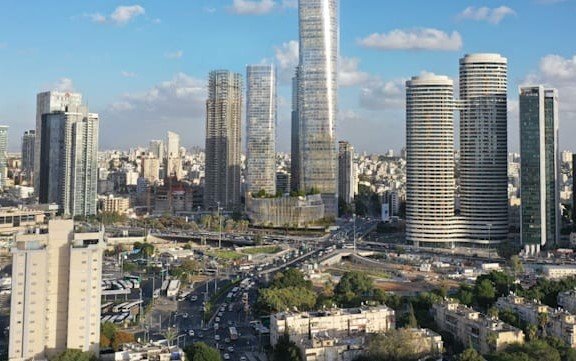Tel Aviv’s iconic Kikar Hamedina square is transforming with three 40-floor residential towers, a vast park, and an artificial lake now in advanced construction stages. This long-awaited project, led by companies Electra and Ashtrom, promises to revitalize the area after decades of delays, with completion expected by 2027.
Project Background and Long Road to Approval
Kikar Hamedina, once a neglected spot surrounded by upscale homes, has seen development plans since the 1960s. Legal battles and planning hurdles stalled progress for years until High Court rulings cleared the way.
The Tel Aviv Municipality issued the building permit in December 2022, ending over seven decades of disputes. Landowners pushed for a mix of luxury housing and public spaces to boost the neighborhood’s appeal.
This shift addresses urban needs in a growing city, where demand for high-end living spaces continues to rise amid Israel’s booming real estate market.
Recent events, like the surge in Tel Aviv’s population and post-pandemic housing trends, have fueled similar projects across the city, making this one a key example of modern urban renewal.

Construction Progress and Engineering Feats
Work on the towers began soon after the permit, with all three structures rising together to meet tight deadlines. Each tower reaches 40 floors, except one at 37, housing a total of 453 luxury apartments averaging 150 square meters each.
Builders have achieved a rapid pace, completing about seven floors per month, far above the usual three. This efficiency stems from advanced techniques and coordinated efforts between teams.
Underground, the project includes three parking levels, with two for residents and one public, easing traffic in this busy district.
A large park and artificial lake will cover 30,000 square meters, creating green space in the heart of Tel Aviv. As of September 2025, the towers are topped out and internal work is underway, with full occupancy slated for 2027.
Key Features of the Development
The project blends luxury living with public amenities to transform the square into a vibrant hub. Here are some standout elements:
- Three spiraling towers offering panoramic city views.
- Over 400 apartments designed for high-end buyers.
- A central park with walking paths and recreational areas.
- An artificial lake for aesthetic and environmental benefits.
- Integrated infrastructure upgrades, including better roads and utilities.
These features aim to make Kikar Hamedina a model for sustainable urban design in Israel.
Economic Impact and Real Estate Trends
The development is boosting local property values, with average prices at NIS 65,000 per square meter. Some units have sold for up to NIS 80,000 per square meter, reflecting strong demand.
Recent sales data shows the market’s heat. For instance, high-floor apartments fetched premium rates, signaling investor confidence despite economic fluctuations.
This project ties into broader trends, like Israel’s 2025 real estate surge driven by tech growth and foreign investment. Nearby properties have seen value increases of up to 15 percent since construction started.
Traffic flow may improve with new parking, but experts predict short-term disruptions. Long-term, the area could attract more businesses, from luxury shops to cafes, enhancing economic vitality.
| Apartment Type | Floor | Sale Price (NIS) | Price per Sq M (NIS) | Sale Date |
|---|---|---|---|---|
| Four-room | 38 | 10.63 million | 75,913 | December 2024 |
| Four-room | 39 | 9.59 million | 68,520 | May 2024 |
| Four-room | 38 | 9.58 million | 68,405 | April 2024 |
This table highlights recent transactions, all for 140 square meter units, showing consistent high values.
Experts forecast that full completion will further elevate prices, drawing comparisons to other Tel Aviv hotspots like the Azrieli Towers area.
Community Reactions and Future Outlook
Residents and landowners express excitement, with 250 owners set to receive apartments. Many praise the blend of private luxury and public green space as a win for the community.
However, some worry about affordability, as prices exclude average buyers. Urban planners see it as a step toward inclusive development, potentially inspiring similar projects nationwide.
Looking ahead, the square could become a cultural landmark, hosting events and drawing tourists. With Israel’s economy rebounding in 2025, this transformation underscores Tel Aviv’s role as a dynamic city.
What do you think about this urban makeover? Share your thoughts in the comments and spread the word to friends interested in real estate trends.
